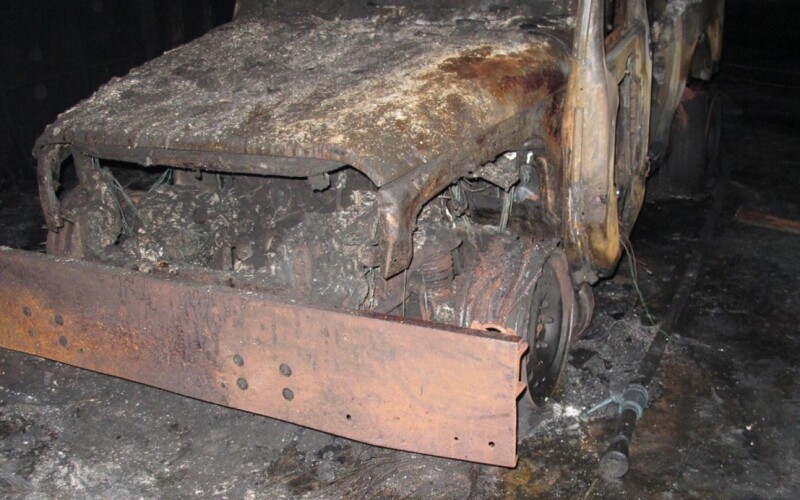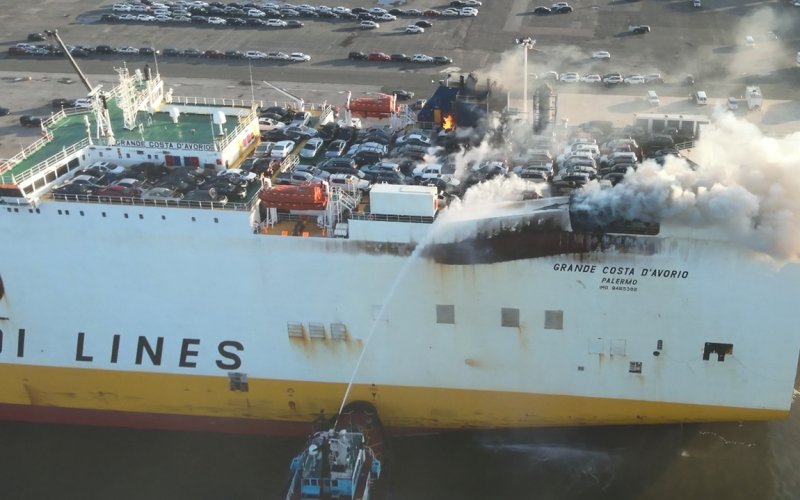Local firefighters in port cities should be better prepared for when blazes erupt on vessels, based on findings from a fatal 2023 fire on the roll-on/roll-off container vessel Grande Costa D’Avorio in Newark, N.J., the National Transportation Safety Board says.
On July 5, 2023, the 692’x118’ Grande Costa d’Avorio was docked at Port Newark with shoreside workers loading new and used cars onto an interior deck of the vessel. with new and used cars. Around 9:30 p.m. a “pusher” vehicle used in the loading caught fire.
The ship’s captain ordered use of the vessel’s carbon dioxide extinguishing system. “But the crew was unable to close a large rampway door because the control panel was located inside the fire protection zone (where the carbon dioxide would be released),” according to a summary of NTSB findings.
“The lack of operating controls on the outside of the door prevented the crew from safely closing the door and directly led to the ineffectiveness of the fire extinguishing system, contributing to the fire’s duration and severity.”
Veteran Newark Fire Department captains Augusto ‘Augie’ Acabou, 45, and Wayne ‘Bear’ Brooks Jr., 49, died trapped amid burning vehicles.
“The NTSB found that directing firefighters to enter the area where the CO2 extinguishing system had been activated, contrary to general marine firefighting convention, exposed firefighters to additional and unnecessary risk,” according to the statement issued after the NTSB board meeting in Washington, D.C. “The Newark Fire Division was also not adequately prepared to respond to a vessel fire and lacked marine vessel firefighting training.”
The fire was triggered in a “pusher vehicle” that dock workers used to nudge cars and trucks up and down ramps to decks on ro/ro ships. It started when overheated transmission fluid of the pusher vehicle, a converted 2008 Jeep Wrangler, boiled over and ignited on a hot engine surface, according to the NTSB investigators.

“The Jeep was a passenger vehicle, and not suitable for use as a power industrial truck because it did not meet Occupational Safety and Health Administration, or OSHA, standards for a power industrial truck,” according to the board. The board called on OSHA to “provide guidance in proper enforcement of the powered industrial truck and emergency procedures requirements at marine terminals and during longshoring operations to assure safe and healthy working conditions.”
To the Newark Fire Division and the Port Authority of New York and New Jersey, the American Association of Port Authorities, the International Association of Firefighters, the International Association of Fire Chiefs, and the National Volunteer Fire Council, the NTSB made recommendations to “improve land‑based firefighting departments’ marine vessel firefighting training and familiarity.
To ensure that shoreside personnel are aware of what to do in the event of a fire on board a vessel, the NTSB recommended that Ports America and American Maritime Services develop policies for emergencies, including accounting for all employees.”
For maritime operators and regulators, the NTSB told Grimaldi Deep Sea, the ship owner, it should inventory “all their vessels to identify all openings that are part of a fire boundary and modify their vessels so that the openings are capable of being closed from outside the protected space.”
Likewise, the vessel classification society RINA Services should revise procedures for review and approval of vessel plans to “ensure that fire boundary openings to spaces protected by fixed gas fire extinguishing systems can be closed from outside the protected space,” the board said.
As for the U.S. Coast Guard, the service should propose that the International Maritime Organization (IMO) clarify an International Convention for the Safety of Life at Sea regulation on fire boundary openings.
The change should require that “all openings capable of admitting air into or allowing gas to escape from a protected space can be closed from outside the protected space applies, regardless of their expected operational condition when in port or at sea.”
The meeting summary, probable cause, findings and safety recommendations of the investigation are available on the investigation webpage. The final report will be published on the NTSB’s website in several weeks.




